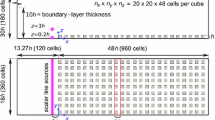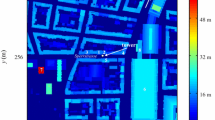Abstract
The sensitivity of turbulence-development to inflow turbulent statistics is investigated in microscale urban atmospheric environment flows. Large-eddy simulations (LESs) are carried out, in which the inflow error is brought in by transforming a fully developed turbulent field according to the Reynolds stress or energy spectra. A theoretical analysis is performed by neglecting the diffusion term in the budget equations of the turbulent kinetic energy. The results show that, (i) the error caused by the Reynolds stress decays until the fully developed level is achieved, and (ii) the error caused by the characteristic length scale increases immediately and then decreases. The streamwise changing rate of the inflow error weakens when the vertical coordinate increases. Further testing of the effects of the inflow inner- and outer-layer data shows that, the inflow inner-layer data dominate the near field, and the inflow outer-layer data dominate the far field.
Similar content being viewed by others
Abbreviations
- A f :
-
frontal area ratio
- A p :
-
projection area ratio
- \({D_{{k^0}}}\) :
-
diffusion term in the turbulent kinetic energy budget equation in the baseline case
- \({D_{{k^e}}}\) :
-
diffusion term in the turbulent kinetic energy budget equation in the testing case
- E :
-
(k e/k 0)1/2
- E uu :
-
wave spectrum of the streamwise velocity
- h :
-
side length of the cubical roughness
- k 0 :
-
turbulent kinetic energy in the baseline case
- k e :
-
turbulent kinetic energy in the testing case
- L x , L y , L z :
-
domain sizes in the streamwise, lateral, and vertical directions
- l 0 (z) :
-
characteristic length scale in the baseline case
- l e (z) :
-
characteristic length scale in the testing case
- \({P_{{k^0}}}\) :
-
production term in the turbulent kinetic energy budget equation in the baseline case
- \({P_{{k^e}}}\) :
-
production term in the turbulent kinetic energy budget equation in the testing case
- p̂ :
-
filtered pressure
- R 0 ij (z) :
-
Reynolds stress in the baseline case
- R e ij (z) :
-
Reynolds stress in the testing case
- Ŝ ij :
-
deformation tensor of the resolved velocity
- P :
-
averaged mean pressure
- ν :
-
kinematic viscosity coefficient
- U, V, W :
-
averaged mean velocities in the streamwise, lateral, and vertical directions, respectively
- u e :
-
characteristic turbulent velocity in the testing case
- u 0 :
-
characteristic turbulent velocity in the baseline case
- û, v̂, ŵ :
-
filtered velocities in the streamwise, lateral, and vertical directions
- δ :
-
boundary layer depth
- ρ :
-
air density
- x, y, z :
-
coordinate in the streamwise, lateral, and vertical directions
- ν t :
-
subgrid-scale eddy-viscosity
- ϕij :
-
redistribution term in the budget equation of 〈u′ i u′ j 〉
- τ ij :
-
subgrid-scale stress
- \({\varepsilon _{{k^0}}}\) :
-
dissipation term in the turbulent kinetic energy budget equation in the baseline case
- \({\varepsilon _{{k^e}}}\) :
-
dissipation term in the turbulent kinetic energy budget equation in the testing case
References
Liu, Y. S., Miao, S. G., Zhang, C. L., Cui, G. X., and Zhang, Z. S. Study on micro-atmospheric environment by coupling large eddy simulation with mesoscale model. Journal of Wind Engineering and Industrial Aerodynamics, 107-108, 106–117 (2012)
Xie, Z. T. and Castro, I. P. Large-eddy simulation for flow and dispersion in urban streets. Atmospheric Environment, 43, 2174–2185 (2009)
Castro, I. P., Xie, Z. T., Fuka, V., Robins, A. G., Carpentieri, M., Hayden, P., Hertwig, D., and Coceal, O. Measurements and computations of flow in an urban street system. Boundary-Layer Meteorology, 162, 207–230 (2016)
Kim, J. J. and Baik, J. J. Effects of inflow turbulence intensity on flow and pollutant dispersion in an urban street canyon. Journal of Wind Engineering and Industrial Aerodynamics, 91, 309–329 (2003)
Xie, Z. T. and Castro, I. P. Efficient generation of inflow conditions for large eddy simulation of street-scale flows. Flow Trubulence Combust, 81, 449–470 (2008)
Smirnov, A., Shi, S., and Celik, I. Random flow generation technique for large eddy simulations and pargicle-dynamics modeling. Journal of Fluids Engineering, 123, 359–371 (2001)
Jarrin, N., Benhamadouche, S., Laurence, D., and Prosser, R. A synthetic-eddy-method for generating inflow conditions for large-eddy simulations. International Journal of Heat and Fluid Flow, 27, 585–593 (2006)
Perret, L., Delville, J., Manceau, R., and Bonnet, J. P. Generation of turbulent inflow conditions for large eddy simulation from stereoscopic PIV measurements. International Journal of Heat and Fluid Flow, 27, 576–584 (2006)
Perret, L., Delville, J. L., Manceau, R. M., and Bonnet, J. P. Turbulent inflow conditions for large-eddy simulation based on low-order empirical model. Physics of Fluids, 20, 075107 (2008)
Spille-Kohoff, A. and Kaltenbach, H. J. Generation of turbulent inflow data with a prescribed shear-stress profile: DNS/LES progress and challenges. Proceedings of the Third AFOSR International Conference on DNS/LES, Technische University, Berlin (2001)
Lund, T. S., Wu, X., and Squires, K. D. Generation of turbulent inflow data for spatially developing boundary layer simulation. Journal of Computational Physics, 140, 233–258 (1998)
Schlüter, J. U., Pitsch, H., and Moin, P. Large-eddy simulation inflow conditions for coupling with Reynolds-averaged flow solvers. AIAA Journal, 42, 478–484 (2004)
Keating, A., Piomelli, U., Balaras, E., and Kaltenbach, H. J. A priori and a posteriori tests of inflow conditions for large-eddy simulation. Physics of Fluids, 16, 4696–4712 (2004)
Leonardi, S. and Castro, I. P. Channel flow over large cube roughness: a direct numerical simulation study. Journal of Fluid Mechanics, 651, 519–539 (2010)
Xie, Z. T., Coceal, O., and Castro, I. P. Large-eddy simulation of flows over random urban-like obstacles. Boundary-Layer Meteorology, 129, 1–23 (2008)
Nelson, M. A., Brown, M. J., Halverson, S. A., Bieringer, P. E., Annunzio, A., Bieberbach, G., and Meech, S. A case study of the weather research and forecasting model applied to the joint urban 2003 tracer field experiment, part 1: wind and turbulence. Boundary-Layer Meteorology, 158, 285–309 (2015)
Kanda, M. Large-eddy simulations on the effects of surface geometry of building arrays on turbulent organized structures. Boundary-Layer Meteorology, 118, 151–168 (2006)
Kanda, M., Moriwaki, R., and Kasamatsu, F. large-eddy simulation of turbulent organized structures within and above explicitly resolved cube arrays. Boundary-Layer Meteorology, 112, 343–368 (2003)
Xie, Z. and Castro, I. P. LES and RANS for turbulent flow ovr arrays of wall mounted obstacles. Flow Turbulence and Combust, 76, 291–312 (2006)
Wang, B., Wang, Z., Cui, G., and Zhang, Z. Study on the dynamic characteristics of flow over building cluster at high Reynolds number by large eddy simulation. Science China Physics, Mechanics and Astronomy, 57, 1144–1159 (2014)
Meneveau, C., Lund, T. S., and Cabot, W. H. A Lagrangian dynamic subgrid-scale model of turbulence. Journal of Fluid Mechanics, 319, 353–385 (1996)
Grötzbach, G. Direct numerical and large eddy simulation of turbulent channel flows. Encyclopedia of Fluid Mechanics, 6, 1337–1391 (1987)
Coceal, O., Thomas, T. G., Castro, I. P., and Belcher, S. E. Mean flow and turbulence statistics over groups of urban-like cubical obstacles. Boundary-Layer Meteorology, 121, 491–519 (2006)
Castro, I. P., Cheng, H., and Reynolds, R. Turbulence over urban-type roughness: deductions from wind-tunnel measurements. Boundary-Layer Meteorology, 118, 109–131 (2006)
Cheng, H. and Castro, I. P. Near wall flow over urban-like roughness. Boundary-Layer Meteorology, 104, 229–259 (2001)
Author information
Authors and Affiliations
Corresponding author
Additional information
Project supported by the National Natural Science Foundation of China (Nos. 11132005, 11490551, and 11322221)
Rights and permissions
About this article
Cite this article
Li, H., Cui, G. & Zhang, Z. Development of inflow turbulence in microscale urban atmospheric environment. Appl. Math. Mech.-Engl. Ed. 38, 1377–1396 (2017). https://doi.org/10.1007/s10483-017-2247-6
Received:
Revised:
Published:
Issue Date:
DOI: https://doi.org/10.1007/s10483-017-2247-6




